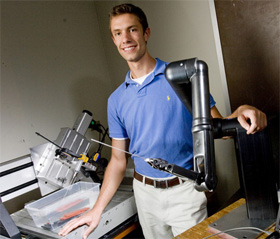An innovative robot from Duke University is able to locate metal fragments in the body and direct therapeutic tools towards them. The robot has applications in removing shrapnel on the battlefield, and in implanting radioactive 'seeds' to treat cancer

One morning last May, Alfred Mann woke up and immediately felt that something was different. For the first time in 65 years, he was able to speak clearly and chew solid food with ease. On close inspection, Mr. Mann found a metal shard on the bed pillow. This fragment, one of many fragments embedded in his body at the Battle of Monte Cassino in 1944, was never discovered by surgeons, and remained hidden in Mann's jaw for over a century.
Alfred Mann's story represents the hardships of many wounded people - starting from the Second World War and ending with the Second Lebanon War. Human doctors and surgeons, for all their skill, are well aware of their limitations. Many times they encounter difficulties in locating shrapnel that penetrated the body on the battlefield, or in removing them. This problem is widely known, but has not yet received an adequate answer, except perhaps in science fiction books and movies. In these works from the distant future, the medical robot stars - a miraculous device that hovers over the injured human body and checks its health status and everything that needs to be repaired. After a quick survey, the robot pulls out its mechanical hands and operates on the injured with an expertise that surpasses that of any human surgeon. Such robots may be on board the ship Enterprise, or even in a miniature version on the futuristic battlefield. As of today, there is a preliminary version of such a robot at Duke University in the United States.
The new robot, the brainchild of a group of bioengineers, is not yet capable of administering paracetamol or cauterizing open wounds, but it is endowed with the one talent superior to that of human surgeons: it locates tiny metal shards embedded in flesh, and directs a needle to the point where the shard is fixed. All this, without human guidance or help. In the future, the robot is intended to handle metal fragments that penetrated the flesh on the battlefield, but it also has a purpose in peacetime. The same robot will be able to implant or remove radioactive 'seeds', which are used to treat prostate cancer and other cancers.
The engineers began the craft of creation with a basic desktop robot, whose eyes are based on state-of-the-art XNUMXD ultrasound technology. The robot's brain is operated using artificial intelligence programming, which receives the three-dimensional information from the eyes, processes it and instructs the robot to move its limbs accordingly. The researchers used this approach in the past to locate calcified areas in simulated breast tissue, but in the current experiments, Rogers added an electromagnet to the end of the ultrasound transducer - the device that launches and receives the ultrasound waves. This element allowed the robot to locate a tiny piece of metal in a water bath, and guide a needle mounted on the end of a robotic arm in its direction.
"We attached an electromagnet to our XNUMXD detector, and it caused the fragment to vibrate precisely enough that its movement could be traced," said A.G. Rogers, who just graduated with a bachelor's degree in bioengineering from Duke University. "The movement of the shard, caused by the electromagnet, was not visible to the human eye, but in the XNUMXD color Doppler system, the moving shard was visible in a clear red color."
"Once the coordinates of the shrapnel were determined by the computer," Rogers concluded, "he successfully guided a needle into the area of the shrapnel."
How does aiming a needle help treat a splinter? According to the researchers, this is only a preliminary experiment. In more advanced experiments, the needle will be replaced by another tiny tool, such as tweezers, which will be able to penetrate into the meat and remove the problematic fragments. Since the researchers received positive results using a relatively simple robot, and basic artificial intelligence programming, they are convinced that simple and safe procedures will become part of the routine of medical care in the future, especially as robots and artificial intelligence technology improve.
"We showed that, in principle, the system works," said Stephen Smith, director of the Ultrasound Transduction Group at Duke University, and a senior member of the research team. "With conventional methods, it can be very difficult to detect small pieces of shrapnel, especially in the field. The military has a large-scale plan to develop the use of surgical robots in the field, and this progress could play a role."

4 תגובות
What makes a robot do this job more accurately than a human surgeon? What is the factor that allows him to be more precise in treatment? After all, even a human surgeon could see on the computer monitor (or in XNUMXD through special glasses) where the fragment is and remove it with tweezers, so what is the added value of the robot in the process?
Let sensitive areas be cut
what kinky??
Want to see a human fountain? Hahaha... it can definitely be entertaining to treat like this.
Put the injured person straight into the MRI room, activate, and take cover 🙂
In the blessing, it won't happen to us,
Moshe.
Why not put the injured person in a huge magnet that will pull out all the fragments at once, it's like taking off a band-aid!